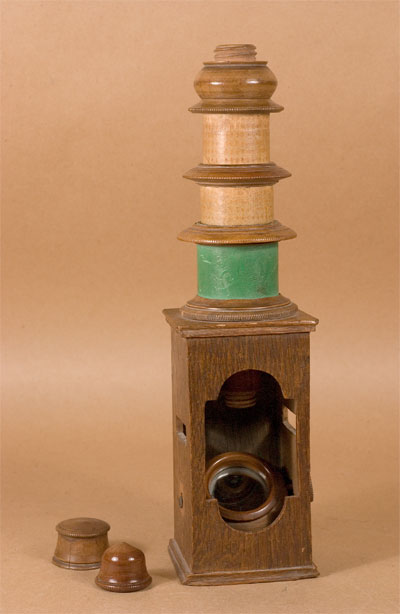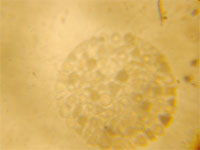 |
|||||
 |
 |
||||
 |
|||||
 |
 |
||||
Sentry-Box Nuremberg Microscope (No. 56 ) |
||||||||||
 |
Age: possibly 1841 Made by: unknown Made in: Nuremberg, Germany |
|||||||||
 |
||||||||||
|
“Augsburgum [Augsburg], Oct[obris] 1841 f[e]c[i]t”
This microscope is the first material evidence that supports Henri van Heurck’s statement regarding the so-called Nuremberg microscopes. |
||||||||||
 |
||||||||||
|
Imaging
|
||||||||||
|
This is a wooden "Sentry-Box" type of compound microscope from the Nuremberg region of Germany. It is constructed of a wooden base (possibly oak) with an enclosed single-sided mirror. Two side cut-outs leave space for sample slides. Attached to the top is a cardboard sleeve with turned wooden ornamental ends. It is covered in tooled shagreen. The microscope body tube fits inside this sleeve. The body is made in two cardboard sections fitted together with turned wooden ornamental rings. It is covered with painted paper. Optically, this microscope has the typical three lenses of the 18th and 19th Centuries: the eyepiece, field, and objective lenses. Each is a single piece of glass. The field and eyepiece lenses are mounted to the top body tube. The objective is mounted to the bottom tube. All three are held in place with metal rings. The eyepiece and objective can be protected with screw-on wooden dust caps. Imaging using this microscope is quite poor, due in part to the poor lighting provided by the mirror. This microscope in the Golub Collection appears to be from the mid-19th Century. It has handwriting on the inside wall and outside of the body tube. One line clearly shows the date "1841". There are no accessories with this instrument. Nuremberg-type microscopes were manufactured in the toy district of Germany (near Nuremberg) from the late 18th through the middle of the 19th Century. This area produced a large number of instruments, thus there are numerous examples in instrument collections around the world. Clay and Court (1932), described a "Nurrenberg" Culpeper-type instrument used by Ehrenberg (dated around 1820). There were two instruments in the Nachet Collection, both dated "...end of the eighteenth century or the beginning of the nineteenth century." The Museum Boerhaave has eight Culpeper-type and five sentry-box-type instruments, all dated 1800–1850. Turner (1989) describes three Nuremberg microscopes, dated "1/2 19th C". The Museo di Storia Della Scienza in Florence has two (dated "1/2 19th C"), and the Billings Collection has nine (all dated earlier). There were four styles: Culpeper-type, Sentry box-type, Solar, and Side Pillar-type. Interestingly, for such a large population all instruments look virtually identical. |
||||||||||
| Featured 11/2007 | ||||||||||